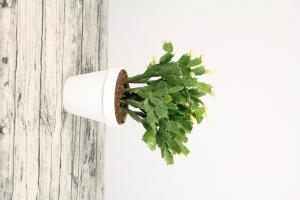How to Prune and Train Tomato Plants
Tomatoes are a popular vegetable among home gardeners due to their versatility and delicious taste. However, their growth habit can be unpredictable and they require proper pruning and training to ensure the best results. In this article, we will discuss the steps you need to take to prune and train tomato plants for optimal growth and yield.
Step One: Remove Suckers
Suckers are small shoots that grow between the main stem and the branch of a tomato plant. While they may seem harmless, they can deplete the plant's resources and reduce the amount of fruit produced. To remove suckers, use sterilized pruning shears to cut them off when they are small, about ? inch in size. Be careful not to remove too much growth from the plant, as this can cause stress and reduce yield.
Step Two: Support the Plant
Tomato plants need support to grow straight and tall, and prevent fruit from touching the ground. There are several ways to support a tomato plant, including using cages, stakes, or trellises. Choose the method that works best for your planting space and budget. Whatever method you choose, make sure to secure the plant to the support structure using soft ties or twine to avoid damaging the stem.
Step Three: Prune the Lower Leaves
As a tomato plant grows, its lower leaves may turn yellow and become shaded by the upper foliage. These leaves are no longer serving the plant and can be pruned away. Use sterilized pruning shears to remove the lower leaves, leaving only a few at the base of the stem. This will allow better airflow to the plant and prevent pest infestations.
Step Four: Thin Out Excess Foliage
Tomato plants naturally produce a lot of foliage, which can limit the amount of sunlight and air circulation that reaches the fruit. To prevent this, thin out the excess foliage by removing any leaves that are growing inwards or blocking sunlight. Leave only the healthy, strong foliage to support the plant and allow for proper photosynthesis.
Step Five: Prune for Fruit Production
The ultimate goal of pruning is to increase fruit production. To do this, concentrate on the main stem and remove any additional branches that are taking away from the plant's energy. Focus on creating a central leader or main stem, and prune away any branches that are growing inwards or downwards. Remember to use sterilized pruning shears and make clean cuts to avoid damaging the plant.
Step Six: Maintenance Pruning
Even after you have completed major pruning, it is important to maintain your tomato plant throughout the growing season. Remove any additional suckers that grow, as well as any branches or leaves that show signs of disease or pest infestation. Regular maintenance pruning will help to ensure that your plant stays healthy, strong, and continues to produce delicious fruit.
In conclusion, pruning and training tomato plants is an important step in ensuring a healthy and bountiful harvest. With the right tools and knowledge, you can help your plants grow stronger, healthier, and with higher yields. Remember to prune judiciously, support your plants with a structure, and maintain them throughout the season for maximum benefits.

 how many times do yo...
how many times do yo... how many planted tre...
how many planted tre... how many pine trees ...
how many pine trees ... how many pecan trees...
how many pecan trees... how many plants comp...
how many plants comp... how many plants can ...
how many plants can ... how many plants and ...
how many plants and ... how many pepper plan...
how many pepper plan...































